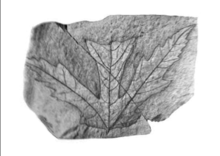Acer chaneyi
|
Acer chaneyi Temporal range: Late Oligocene - Miocene |
|
|---|---|
 |
|
| A. chaneyi (holotype), University of California Museum of Paleontology, Berkeley, CA. | |
| Scientific classification | |
| Kingdom: | Plantae |
| Clade: | Angiosperms |
| Clade: | Eudicots |
| Clade: | Rosids |
| Order: | Sapindales |
| Family: | Sapindaceae |
| Genus: | Acer |
| Section: | A. sect. Rubra |
| Species: |
†A. chaneyi Knowlton, 1926 |
| Binomial name | |
|
Acer chaneyi |
|
| Synonyms | |
|
Rhus oregonenis |
|
Rhus oregonenis
Urena miocenica
Acer chaneyi is an extinct maple species in the family Sapindaceae described from a number of fossil leaves and samaras. The species is known from Oligocene to Miocene sediments exposed in Alaska, Idaho, Nevada, Oregon and Washington in the U.S. It is one of several extinct species belonging to the living section Rubra.
Acer chaneyi is known from leaf and samara specimens which were recovered from a number of different formations in Western North America. The oldest occurrence is from the possibly Early Oligocene Gumboot Mountain flora of Southern Washington state followed by the Late Oligocene Kukak Bay flora in Alaska. In the early Miocene A. chaneyi is known from the Alaskan Kanalku Bay flora, Oregon Collawash and Little Butte flora. The Middle Miocene locations include the Skolai Creek flora of Alaska, Grand Coulee and Latah floras of Washington, Mascall flora and Succor Creek floras in Oregon and the Latah and Clarkia flora in Idaho. Further Middle Miocene occurrences in Nevada are the Thurston Ranch flora, Deadman Creek flora, Pyramid flora, Purple Mountain flora, Eastgate flora, and Middlegate floras. Late Miocene occurrences in Oregon are the Weyerhauser flora, Hidden Lake flora, Austin flora, Tipton flora, Stinking Water flora, and Trout Creek floras. Late Miocene occurrences in Idaho are the Cartwright Ranch flora, Horseshoe Bend flora, Alkali Creek flora and Trapper Creek flora. Based on the identified fossil occurrences A. chaneyi has a temporal range of approximately 20 million years, the longest identified for any fossil species in Western North America. The species Acer ferrignoi is a possible descendant species that survived in the Oregon Cascades until 7 million years ago.
...
Wikipedia
